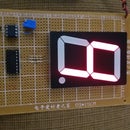Introduction: 6 Bits Binary Counter
This counter is the result of designing a cascading counter because it's constructed like an asynchronous counter of 6 bits. That is, the project needs to function the following components: 6-10mm LEDs, 6-Flip-Flops(IC74LS76), and an IC555 timer for generating the clock signal while 6-1N914.diodes do the interface between the counter and the LEDs so that the codes from 0 to 63 can be generated without any problem.. Although this design is a classical, it's neither easy nor funny but illustrative for learning how a binary counter works.
Step 1: Bill of Materials
What you will need:
6 10mm Red LEDs
6 Diodes, 1N914
3 IC74LS76, Flip-Flops
3 16-pin, IC socket
1 8-pin, IC socket
1 IC555, Timer
1 10K Potentiometer
1 10K Resistor, 1/4 Watt
1 47uF Electrolytic Capacitor
1 7805 Voltage Regulator, +5V
1 9V Battery Clip
1 9V Battery
Some Connecting wires
Soldering Iron
Soldering 60/40 roll
Step 2: Schematics
With the set of schematics included in this step, you have enough information so that you can complete successfully the present instructable.
Step 3: Install LEDs & IC-Sockets
Installing the LEDs and IC sockets, you can connect each other the LED cathodes and solder them too.
Step 4: Install the Diodes
When installing the diodes, you should orient them with the cathodes or black line toward the LEDs in theirs respective anodes for being connected correctly. Also, you have to connect the missing positive terminal of each diode to its respective output of each Flip-Flop by having in count the connections showed in the corresponding schematics.
Step 5: Install the Capacitor
Once installed the capacitor, connect its negative terminal to pin 1 from 8-pin, IC socket while its positive terminal to pin 2 of that same IC socket without forgetting connecting pin 2 to pin 6 too. In this step, you should also connect the GND pins of IC socket to common cathodes of the LEDs.
Step 6: Install the 10K Potentiometer & Resistor
When installing the 10K potentiometer and resistor, you should connect them to 8-pin IC socket. The pin 4 & 8 will later be interconnected to +5V and to one terminal of 10K resistor right away while the pot together have to connected to pin 7 with the remaining terminal of the resistor on its central pin and one side pin, and the free terminal of the pot must be connected to pin 6 interconnected to pin 2 and previously connected to the positive side of the capacitor terminal.
Step 7: Installing the Voltage Regulator & 9V Battery Clip
When installing the voltage regulator & 9V battery clip, you should together connect the central terminal of your voltage regulator to common cathodes of the LEDs and black wire of 9V battery clip while its terminal 1 or input to red wire of 9V battery clip.
Step 8: Connecting the Side Positive of Your Project
Interconnect all J-K, Preset & Clear pins of the Flip-Flops to pin 4 and 8 of IC555 previously connected, output terminal of your voltage regulator and pin 5 of the Flip-Flops as well.
Step 9: Install the IC & Battery
Once concluded all of connections, carefully install the integrated circuit before connecting the battery for avoiding any problem or damage to your proyect.
Step 10: Enjoy It
Enjoy your project that is a classical counter of 6 bits by working perfectly with the help of the 1N914 diodes.













